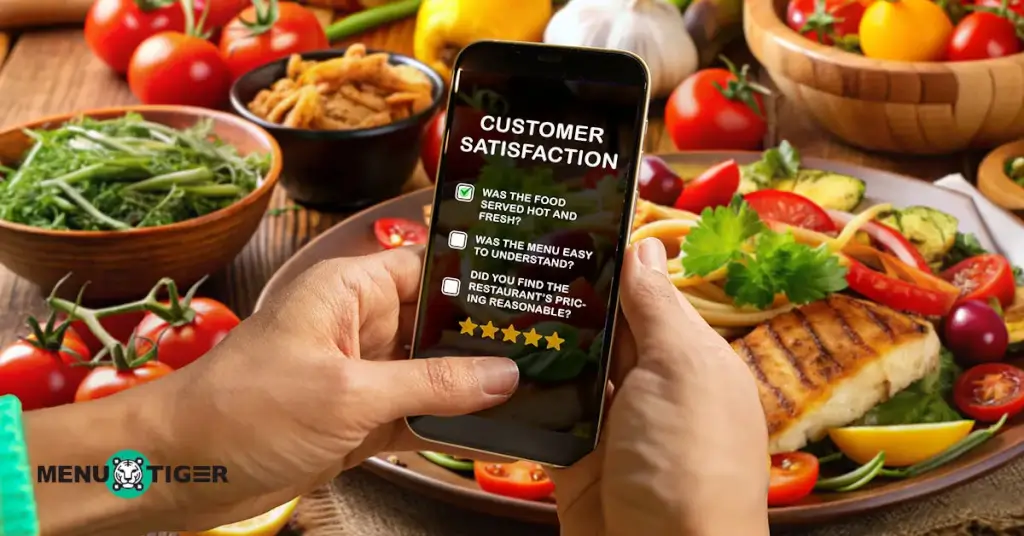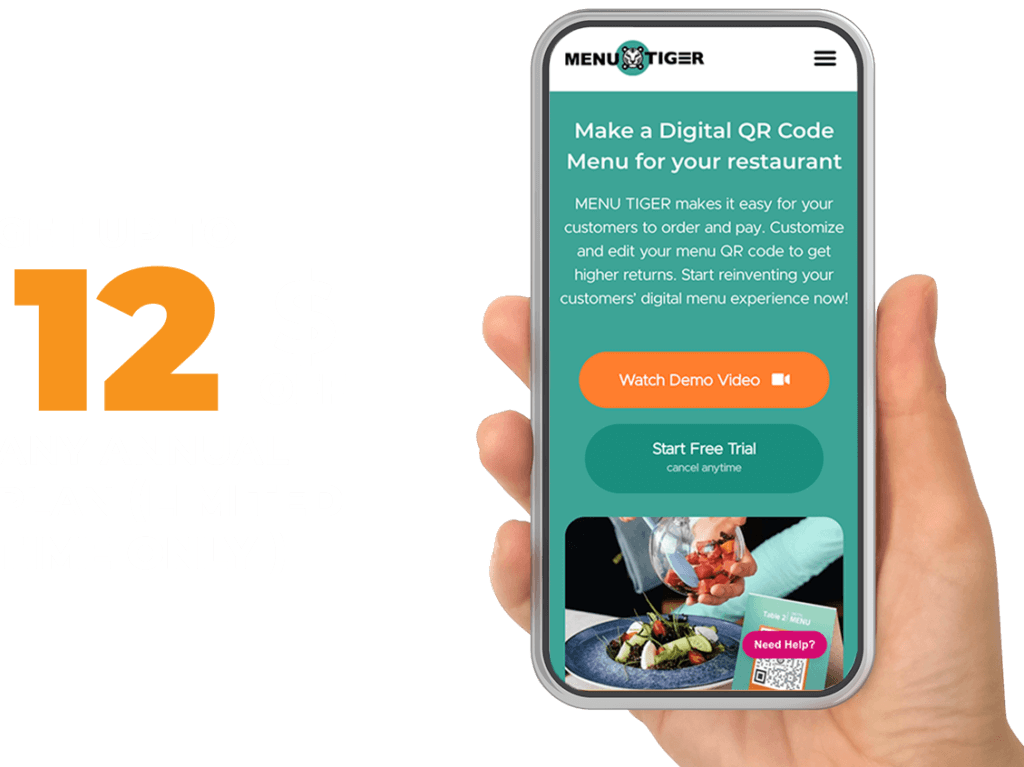One special skill a restaurant should have is the ability to communicate well with its customers to determine what needs improvement in the business.
But it can be tricky since you’re serving a wide demographic that each has unique personalities and preferences.
So, you need a game-changer tool to connect with them — a survey.
Instead of guessing what’s working or what needs tweaking, a good set of restaurant survey questions lays it all out for you — straight from the people who matter most.
Want to know if your new menu items hit the mark or if services could be quicker with advanced tools like restaurant ordering systems and gadgets? A quick survey gives you those insights.
To get you ready and fully equipped, here’s a rundown of essentials you need to know:
Table of Contents
ToggleBenefits of restaurant surveys
The very goal of any restaurant business isn’t all about achieving off-the-chart sales but satisfying every customer as they set their foot out of your store.
Simply because that’s when you can retain them. But how will you know if they are? Well, get their feedback through a survey for food and overall service:
Here’s how you can benefit from it:
- Improving customer satisfaction
Surveys help you get specific feedback on what customers dislike, whether it’s about the food quality, waiting times, or service experience.
By addressing complaints through these, you can resolve issues directly with costumes before they take their frustrations to review platforms.
In fact, McKinsey Company reported that companies that focus on improving customer experience can reduce customer churn by 10 to 15 percent.
- Building customer loyalty
Gathering data on your guests’ preferences and tailoring your future improvements can create a personalized experience for your guests.
This personal touch can enhance their dining experience and increase the likelihood of returning.
In fact, 93 percent of customers are likely to repeat business with companies that offer excellent customer service, so it’s essential that you know exactly what your customers want and need.
- Identifying trends and market shifts
Surveys are a direct line to understanding how consumer tastes evolve. For example, if an increasing number of consumers request healthy alternatives, you can adapt your menu accordingly.
These also help gauge how their expectations around service are changing.
Types of restaurant survey questions to consider
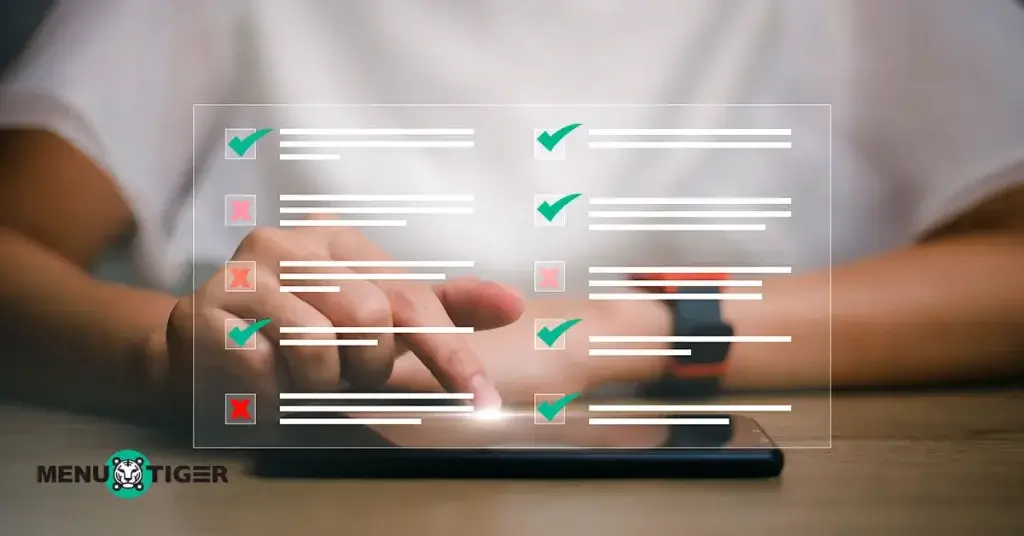
An effective way to get answers to customers is to decide the type of questions to ask in a restaurant survey that works well with your business.
So, you’re not just putting questions out there. You need to use surveys strategically.
Here are various types of survey questions:
- Open-ended vs. closed-ended questions
Open-ended questions invite more elaborate answers that often require participants’ explanation, detail, or reflection.
These questions are useful when you’re seeking deeper insights into your customers’ experiences, motivations, or opinions.
For example, you can ask, “What did you enjoy most about your dining today?” “Can you tell us about any dish that stood out to you and why?” or “ How could we improve your experience with us?”
On the contrary, close-ended questions opt to be answered with a single word, often yes, no, or a simple choice from a pre-defined set of options.
They are more specific and directive, aiming for concise answers.
Use this type of question if you wish to gather more quantifiable data, as the responses are measurable.
- Rating scales and Likert scale questions
Using rating scales in your restaurant feedback questions is a simple way to turn customer opinions into measurable insights.
Above any other reasons, these seem to be easy to grasp, and customers don’t have to input detailed answers.
Let’s say, “How would you rate the speed of service?” You can scale from 1 for extremely slow to 5 for extremely fast for the response.
The same manner in a Likert scale. “The food and drinks were delivered to my table in a timely manner.”
You can put strongly disagree, disagree, neutral, agree, or strongly agree.
- Multiple-choice questions
Using a multiple-choice format, you’ll have more structured feedback that measures specific references.
The questions are coupled with predefined options, so your customers are limited to making choices in a certain bracket.
This helps if you wish to get answers on a particular aspect of your business.

List of restaurant survey questionnaire sample
Food quality and taste
- How would you rate the taste of the dish you ordered?
- Was your meal served at the appropriate temperature?
- How satisfied were you with the portion size?
- How fresh did the ingredients in your meal taste?
- Were the flavors of your dish well balanced?
- Did the food presentation meet your expectations?
- Were there any items you would like to see added to the menu?
- Were there enough healthy options on the menu?
- How would you rate the value of money for the meal you received?
Service
- How would you rate the overall service you received?
- Was the staff friendly and welcoming?
- Did your server check on you at the appropriate times?
- How well did your server handle any special requests?
- How long did you wait to be seated?
- How long did you wait for your food after ordering?
- How knowledgeable was the staff about the menu?
- How satisfied were you with the cleanliness of your table and surroundings?
- Did you feel that your server was attentive without being intrusive?
Ambiance and atmosphere
- How would you rate the overall ambiance of the restaurant?
- Was the restaurant’s atmosphere comfortable and inviting?
- Was the restaurant’s lighting appropriate for the time of the day?
- How would you describe the noise level during your visit?
- How satisfied were you with the overall decor of the restaurant?
- How comfortable were the seating arrangements?
Cleanliness and hygiene
- How would you rate the overall cleanliness of the restaurant?
- Were the restrooms clean and well-maintained?
- Did the cleanliness of the restaurant meet your expectations?
- Were the tables and chairs clean when you arrived?
- Did you notice any cleanliness issues that affect your dining experience?
Menu and beverage selections
- Was there a good variety of food items on the menu?
- How do you rate the selection of beverages?
- Were there enough options for different dietary needs?
- How easy was it to navigate the menu?
- Did you feel the menu reflected the restaurant’s concept and style?
Bar and drinks
- How would you rate the overall quality of the drinks?
- Was your drink served in a timely manner?
- How satisfied were you with the bartender’s service and knowledge?
- How would you rate the variety of cocktails or specialty drinks?
- Did the bar offer any unique or innovative drink options?
Price and value
- How satisfied were you with the prices compared to the quality of the food and service?
- Were the portion sizes reasonable for the price you paid?
- Did you find any particular item on the menu to be overpriced?
Customer experience
- Would you recommend this restaurant to a friend or family member?
- What did you enjoy the most about your dining experience today?
- How likely are you to return to this restaurant in the future?
Dos and don’ts in writing good restaurant survey questions
Once you’ve figured out what type of restaurant feedback questions works for you, let’s discuss how you’ll effectively ask these questions to your customers.
Be clear and concise
Ask one thing at a time and use simple, direct language.
Structure the question to highlight exactly what information you need, and ensure it’s neither too broad nor too vague.
This reduces misinterpretation and prevents lengthy or off-topic responses.
Break down complex inquiries into smaller and more focused components so that your customers can better understand the intention of the questions.
Don’t make assumptions
Avoid making assumptions about your customers having a certain experience.
When you assume that they had one, such as interacting with a bartender or ordering a certain dish, you risk setting apart those who have not experienced them.
This can lead to frustration, incomplete surveys, or skewed results because the questions framed don’t seem to apply to every customer you have.
So, instead of saying, “How would you rate your conversation with the bartender?” you can say, “Did you interact with our bartender during your visit? If so, how would you rate the interaction?”
This approach verifies first whether the customer had the specific experience. If they didn’t, they can skip the follow-up rating question.
Expert’s tip: Put a “Not applicable” option for inclusivity. This prevents forcing guests to answer questions about the experiences they didn’t have.
Keep your restaurant survey questions short

On average, it takes seven and a half seconds to answer an online survey question, says Versta Research.
So, if you’re going to ask at least ten, it would take a customer around one minute to complete a survey.
With this time frame, make sure to limit your survey to a few target questions and avoid overly detailed or repetitive inquiries.
Using a combination of multiple-choice, rating scales, and open-ended questions can help you gather insights without overwhelming them.
This strategy makes your customers feel at ease when taking the survey, making them think it’s not a waste of time but rather a valuable opportunity to express their satisfaction or concerns about your restaurant.
Don’t ignore open-ended customer restaurant feedback
The best feedback can be hidden in the bed of words, so make use of the open-ended questions.
This type of question allows respondents to express their thoughts, opinions, and suggestions in detail, providing you with qualitative insights that can reveal patterns or issues that close-ended questions can’t capture.
So, take time to thoroughly review the feedback. If necessary, use text analysis tools to identify recurring themes.
If possible, acknowledge, respond, and handle online negative reviews and insightful comments.
Target specific aspects of the experience
Ambiguity in asking defeats the purpose of surveys.
Be straightforward and venture into different components of your restaurant.
Remember, the menu does not make up the whole dining experience. So, think about covering your services, hygiene management, and other parts of your business.
For instance, you can ask, “How would you rate the cleanliness of the restaurant?” or “ How effective are our promotions? Do we need any restaurant marketing tools or other marketing essentials to reach you?”
This method allows you to gather detailed and actionable feedback, allowing you to understand what areas are performing well and what needs improvement.
Be neutral in question-wording
Being neutral in your question wording is essential to keep customers’ responses unbiased and honest.
If the questions are phrased to suggest desired responses, respondents may feel inclined to give answers they think you want to hear rather than their true opinions.
For example, instead of asking, “Did you enjoy our fantastic new menu?” use an alternative like, “How would you rate our menu?”
This will help you avoid skewing the result and prevent you from getting authentic restaurant customer feedback.
End with a ‘thank you’
Don’t forget to show appreciation for your costumers’ time and effort rendered in providing feedback.
This simple gesture fosters goodwill and encourages their future participation, creating a lasting impression.
This ensures that customers feel valued and heard, which can build loyalty and motivation that can encourage them to return.
Note: If you’re using the conventional way, you might as well put a digital menu QR code for them to access your appreciation gift cards or other incentives.
Send surveys with ease using a smart QR code menu technology
Once everything is set, the challenge here is how to distribute them to your customers.
Sure, an offline survey has its advantages, and the same goes for using survey sites, which, by the way, are good options.
You can level up and make it more convenient for you and your customers, using a smart menu QR code restaurant technology like MENU TIGER.
Here’s why:
- Customizable survey formats
Using this QR code menu technology, you can now create, edit, and remove your restaurant survey template with just a few clicks.
All you need to do is input your questions and choose the type of questions you want to ask, whether open-ended, Likert, or scale.
- Comprehensive restaurant website
Your feedback is directly reflected in your website, which makes it easier for your customers to respond to the survey at their convenience.
- Accessible through digital restaurant menu QR code
One of the benefits of QR code menu is convenience.
It gives them time and space to become comfortable taking the survey without being pressured by staff, leading to more honest and authentic insights that can help your restaurant grow.
Using QR codes on table tents, tabletops, counters, and even your marketing materials like posters, flyers, and social media assets, your customers can access your survey anywhere, anytime.
How to create surveys using MENU TIGER
1. Create an account.
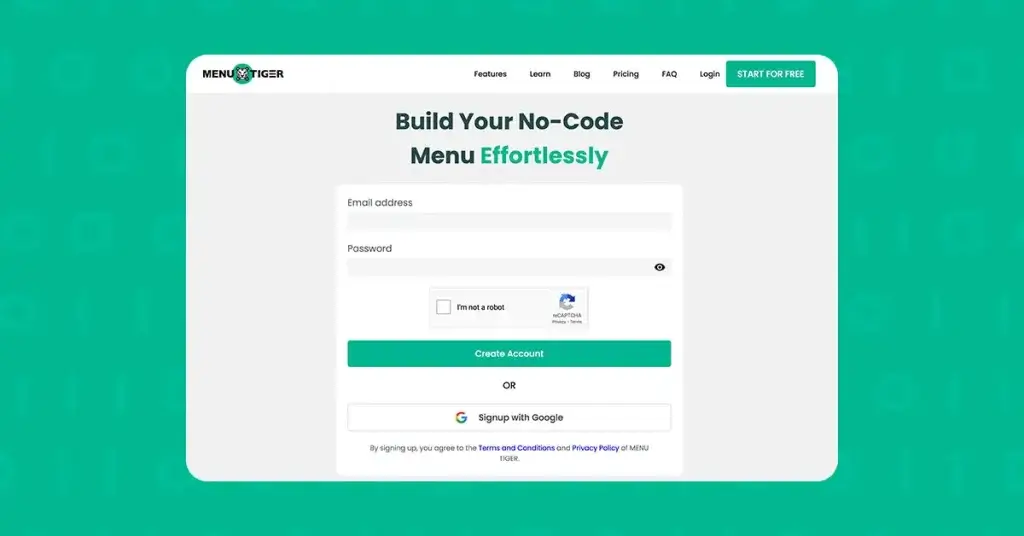
Fill out the box with your email address and password. This is to get access to your admin panel.
2. Make your online menu.
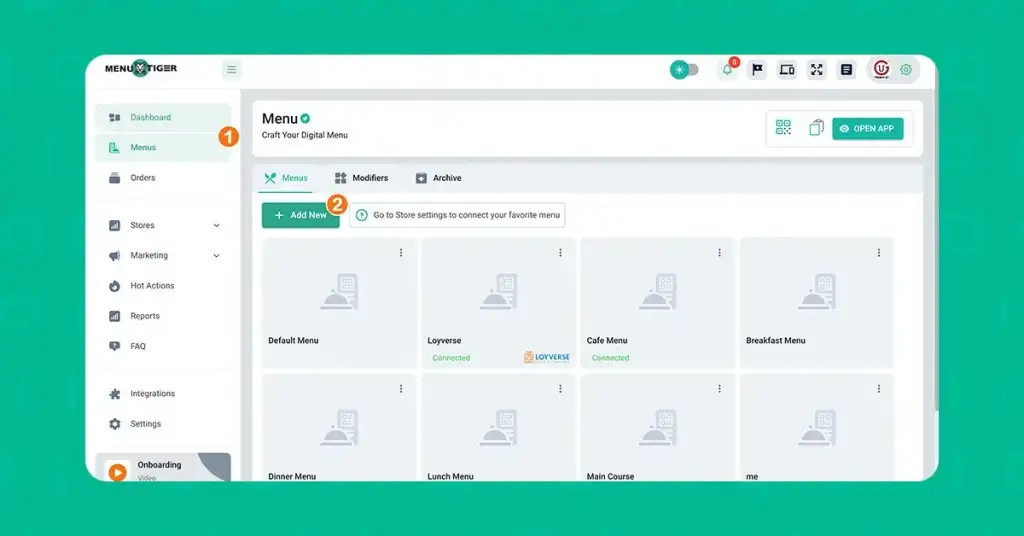
Select Menus on the left side of your admin panel and click Add New to import your food items or start from scratch.
3. Build your website.
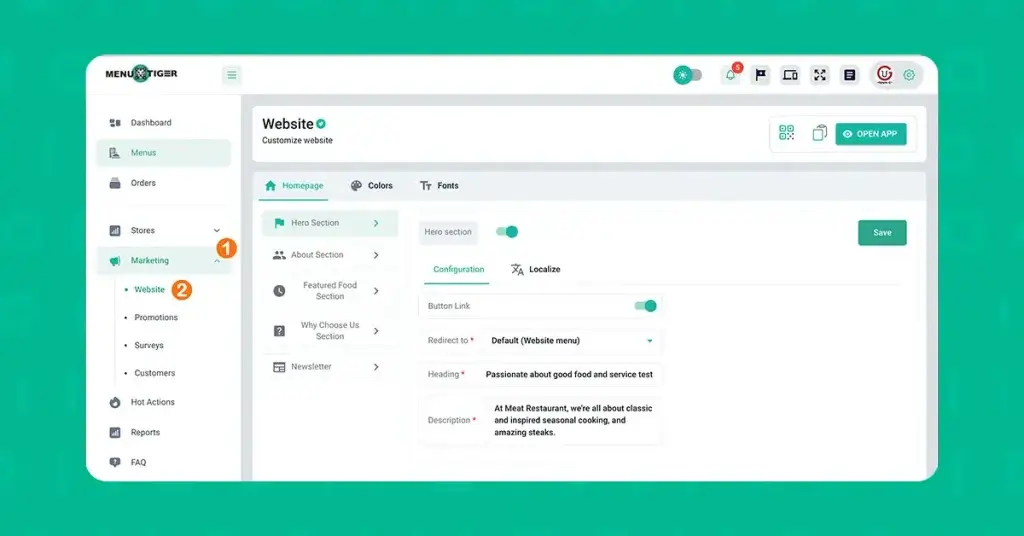
Go to Marketing and select Website to design your own restaurant website. This is where your menu and survey forms are accessed.
4. Create your surveys.
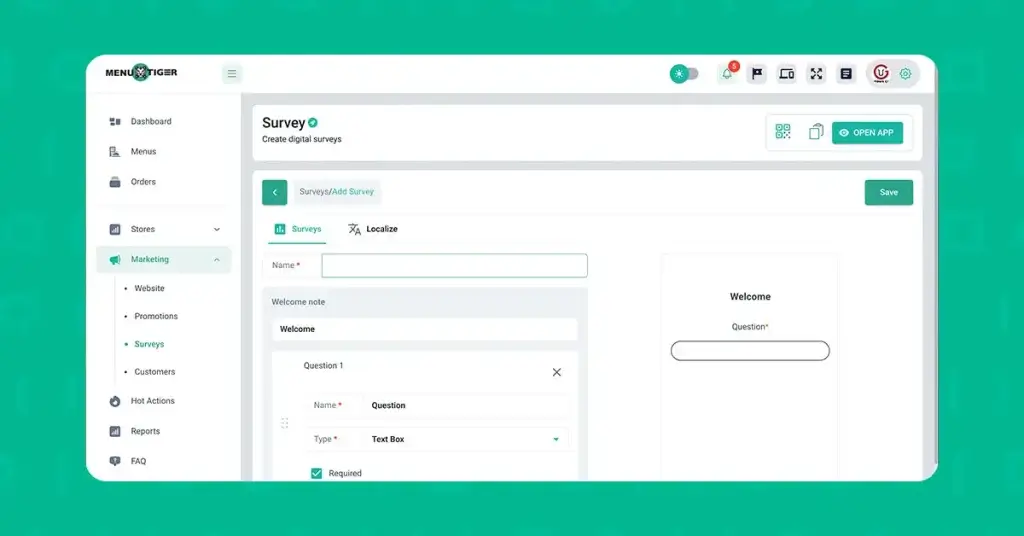
In the same section, go to Surveys and click +Add New to create your survey. Enter the name of the survey and the questions you wish to ask.
The right side shows a preview of your survey as it would look on the customers’ side.
5. Do a test run.

Click the Open App button in the far right corner of your panel to direct you to your website, where you can test-run your surveys.
Select Feedback and personally answer the survey questions.

Get meaningful feedback with MENU TIGER QR code menu software
Framing your restaurant survey questions well gives you an advantage in receiving feedback that assures growth in your business.
You want to ensure that you get the most out of it as a tool for communicating with your customers.
This makes digital solutions, like MENU TIGER, ideal tools not only for streamlining restaurant operations but also for creating and sending survey forms.
You can integrate your survey questions directly into the customer experience, capturing sights when it’s most relevant — right at the table.
There seems to be more of it: ensuring real-time responses and introducing popular menu items to fine-tune operations while reducing the reliance on manual feedback collection.
So, visit the website, sign up, and transform feedback into actionable insights to improve your restaurant’s performance.
FAQs
When crafting a survey, there are five basic questions that can provide valuable insights:
How satisfied are you with your overall experience?
What aspect of our service/product did you like the most?
What areas can we improve to better meet your needs?
How likely are you to recommend our business to a friend or colleague?
Do you have any additional comments or suggestions for us?
These questions blend quantitative feedback with open-ended responses, providing both measurable data and deeper insights into customer experiences and expectations.
When evaluating a restaurant, ask questions that cover key aspects like food quality, service, ambiance, and operations.
It’s also helpful to ask about pricing, the target demographic, and any unique elements that set the restaurant apart, such as sustainability efforts, technology use, or special events.

